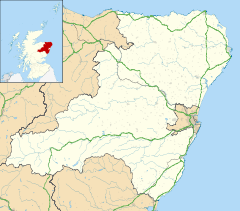Muchalls is a small coastal ex-fishing village in Kincardineshire, Scotland, south of Newtonhill and north of Stonehaven.[1][2] Muchalls is situated slightly north of a smaller hamlet known as the Bridge of Muchalls. At the western edge of Muchalls is the historic Saint Ternan's Church. The rugged North Sea coastline near Muchalls features numerous cliffs, sea stacks and headlands, not infrequently in haar. The Grim Brigs headland is situated at Muchalls southern edge and Doonie Point headland is approximately 1.5 kilometres south.
| Muchalls | |
|---|---|
 | |
Location within Aberdeenshire | |
| Population | 500 (approx) |
| OS grid reference | NO902922 |
| • Edinburgh | 115 mi (185 km) SSW |
| • London | 510 mi (820 km) SSE |
| Council area | |
| Lieutenancy area | |
| Country | Scotland |
| Sovereign state | United Kingdom |
| Post town | STONEHAVEN |
| Postcode district | AB39 |
| Dialling code | 01569 |
| Police | Scotland |
| Fire | Scottish |
| Ambulance | Scottish |
| UK Parliament | |
| Scottish Parliament | |
History
editMuchalls is situated slightly to the east of the ancient Causey Mounth trackway, which was constructed on high ground to ensure passage along the only available medieval route from coastal points south from Stonehaven to Aberdeen. This ancient passage specifically connected the River Dee crossing (where the present Bridge of Dee is situated) via Gillybrands, Muchalls Castle and Stonehaven to the south.[3] William Keith, 7th Earl Marischal and the Marquess of Montrose took that route when they led a Covenanter army of 9000 men in the battle of the Civil War in 1639.[4] From Muchalls Castle to the sea is a secret cave, about one mile long, which smugglers once[when?] used. The cave is said to be haunted by the green lady. The cave has been boarded up at the castle end and at the sea. The portion of the cave near Muchalls's bridge has collapsed just below the railway line.[citation needed]
Charles Dickens visited Muchalls in its heyday as a Victorian resort and declared that Muchalls was a remarkably beautiful place. Footage was recorded in Muchalls for the 1990 film Hamlet.[5] Muchalls is the birthplace of Richard Henry Brunton,[6] the father of Japanese lighthouses.
Transportation
editBetween 1849 and 1950, the village was served by the Muchalls Railway Station, on the Aberdeen Railway, the location of which can be estimated by its proximity to the Muchalls Peace Sign.
The 108 bus between Muchalls and Newtonhill was withdrawn in 2018 due to cost-cutting by Aberdeenshire Council.[7][8] The village now has no public transport.
See also
editReferences
edit- ^ "Muchalls". Gazetteer for Scotland. Archived from the original on 1 March 2019. Retrieved 7 January 2025.
- ^ "Muchalls: Historical perspective for Muchalls". Gazetteer for Scotland. Archived from the original on 3 March 2016. Retrieved 7 January 2025.
- ^ C.Michael Hogan (3 November 2007). Andy Burnham (ed.). "Causey Mounth". Megalithic Portal. Archived from the original on 29 June 2018. Retrieved 7 January 2025.
- ^ Watt, Archibald (1985). Highways and Byways round Kincardine. Stonehaven Heritage Society. ISBN 9780907301097.
- ^ "Where did they film that?". Archived from the original on 10 January 2017. Retrieved 7 January 2025.
- ^ "Centenary memorial service for Richard Henry Brunton". Archived from the original on 14 September 2007.
- ^ Mandi Dorward. "Bus journeys/services withdrawals from 7th May 2018 – NKRCC". Retrieved 5 November 2021.
- ^ "Kincardine and Mearns area bus forum" (PDF). 29 March 2018. Archived (PDF) from the original on 5 November 2021. Retrieved 5 November 2021.
